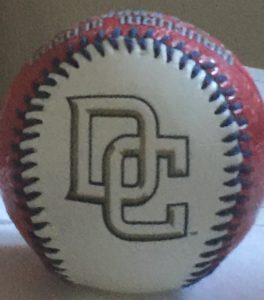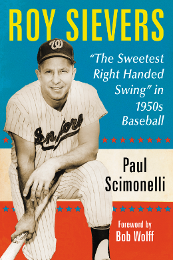October 29
Senator Managers
Jimmy McAleer, 1910-1911
Record as Senator manager: 130-175 .426 Pct.
Teams managed
1910: 66-85, .437 Pct., 7th place, 36.5 GB
1911: 64-90, .416 Pct., 7th place, 38.5 GBUnlike his predecessors, Jimmy McAleer was an experienced big league pilot. The Youngstown, OH native was instrumental in the recruitment of National League players for Ban Johnson’s American League in 1901 and 1902 before peace was achieved between the warring leagues. Johnson, shuffling players and managers between teams at will, would reward McAleer with managerial appointments with the upstart Cleveland Blues (Indians) in 1901, the new St. Louis Browns in 1902 and the Washington Senators in 1910.
Before arriving in the nation’s capital, McAleer managed the Blues for their inaugural season, before heading to St. Louis to lead the Browns to a surprising 2nd place finish in 1902, their high water mark until another 2nd place finish in 1922. McAleer would have only one more winning season in St. Louis during the ensuing 6 years before resigning in September, 1909. At the “suggestion” of Johnson, Senators president Thomas Noyes signed McAleer to a one year, $10,000 contract to manage the Nats.
McAleer steered the rag tag Senators up a notch to 7th place in 1910, improving the Senators won-loss mark by 23.5 games from 1909. Clyde Milan came into his own during this season, stealing 44 bases, and upping his average to .279. The most important development was the continued maturation of Walter Johnson. Instead of using Johnson practically every day, McAleer used Johnson exclusively as a starter, with proper rest between starts. McAleer also gave Johnson an opposing manager’s viewpoint: Johnson could be defeated when he relied too heavily on his curveball. Johnson broke through with a 25-17 record, a 1.36 ERA and 313 strikeouts mixing his pitches.
On the basis of the team’s improvement, Noyes rewarded McAleer with a 2 year contract along with a small ownership stake in the Washington franchise. 1911 would also feature the Senators playing in a new ballpark. 18 days before the opener, Washington’s wooden ballpark caught fire and burnt down. Hastily constructed, a concrete and steel ballpark was erected just in time for the opener. League Park, renamed Griffith Stadium in 1920, would be the home for the Senators until 1961.
The Senators remained stuck in 7th place in 1911 at 64-90. Johnson lead the league in complete games with 36. 1B Germany Schaffer paced the offense with a .334 average. Milan batted .315 and swiped 58 bags, even though McAleer disapproved of the outfielder catching fly balls with one hand.
In mid- September of 1911, McAleer tendered his resignation as manager effective at the end of the season. McAleer and AL Secretary Robert McRoy, with fiancial assistance from Ban Johnson, purchased a half-interest in the Red Sox. McAleer would be named president of Boston in 1912 and the Sox, in their first year at Fenway Park, would win the World Series under former Nats manager Jake Stahl. However, McAleer and Stahl repeatedly clashed, leading to McAleer firing Stahl in July of 1913. Johnson, a secret shareholder in the Red Sox, was angered by McAleer’s decision to can Stahl. With his old friend Johnson refusing to stand behind him, McAleer sold his interest in the Sox and never returned to baseball.
Senators Birthdays
Adelbert William Mason B Oct. 29, 1883 D Dec. 31, 1962
Pitcher Del Mason debuted with the Washington Senators in April of 1904. Pitching in 5 games for Washington, Mason would go 0-3, giving up 45 hits and 22 runs in 33 innings.
Mason would resurface with the Cincinnati Reds in 1906 going 0-1 in 2 games. He’d finish his major league career in 1907, going 5-12 in 25 games, his last appearance coming in mid-August of ’07.
Peter Gerard Richert B Oct. 29, 1939 Still Living
Signed by the Los Angeles Dodgers in 1958, pitcher Pete Richert would debut as a 22 year old rookie in April of 1962. Richert would go 5-4 in his first year, appearing in 19 games. He’d post a 5-3 record in 1963 and 2-3 in 1964.
After the 1964 season, Richert would be a part of the trade that sent Frank Howard, Ken McMullen, Phil Ortega and Dick Nen to Washington for Claude Osteen, John Kennedy and $100,000.
Pitching in Washington, Richert would post a 15-12 record in 1965 and would go 14-14 in 1966. He would be named to the American League All Star Team in both of those years.
Starting the 1967 season in Washington, Richert would see his W/L record drop to 2-6 before he was traded to the Baltimore Orioles for Mike Epstein and Frank Bertania in late May. He’d finish the 1967 season in Baltimore, going 7-10 for the O’s.
Richert would remain in Baltimore through 1971 and would appear in 1 game of each World Series in 1969, 1970 & 1971.
After the 1971 season, Richert would be traded back to the franchise where it began, the Los Angeles Dodgers where he’d play in 1972 & 1973.
He’d be traded one last time after the ’73 season to the St. Louis Cardinals where he’d pitch in 13 games before being sold to the Philadelphia Phillies. Richert would pitch in 21 games for the Phillies, his last major league appearance coming in early September of 1974.
Earl Hershey Yingling B Oct. 29, 1888 D Oct. 2, 1962
Completing our trio of pitchers who were born on October 29th, Earl Yingling would debut in 1911 with the American League Cleveland franchise then known as the Naps. He’d post a 1-0 record in 4 games for Cleveland.
Yingling would make his way east, pitching for the Brooklyn Dodgers in 1912 & 1913. Selected off waivers in 1914, Yingling would pitch in 34 games for the Cincinnati Reds, posting a 9-13 record.
After a 3 year absence from the majors, Yingling would make his way into 5 games for the 1918 Washington Senators, posting a 1-2 record with Yingling’s last major league game would come in late May of 1918.






